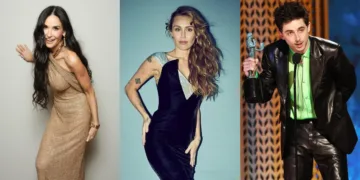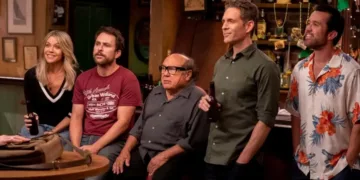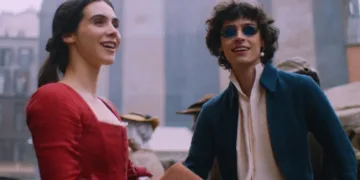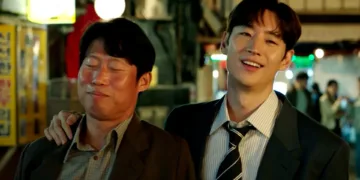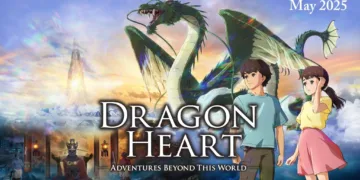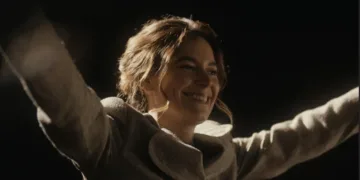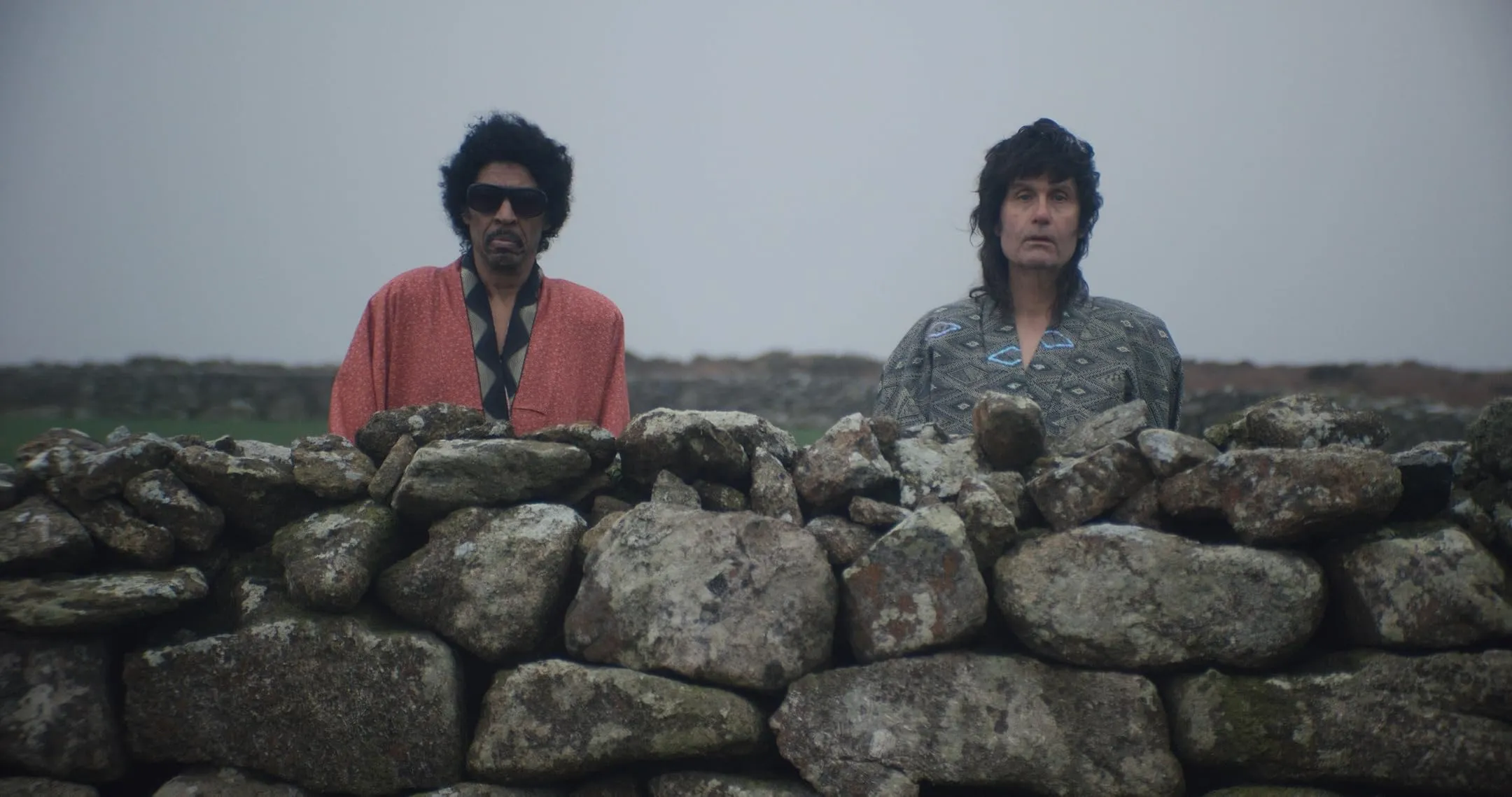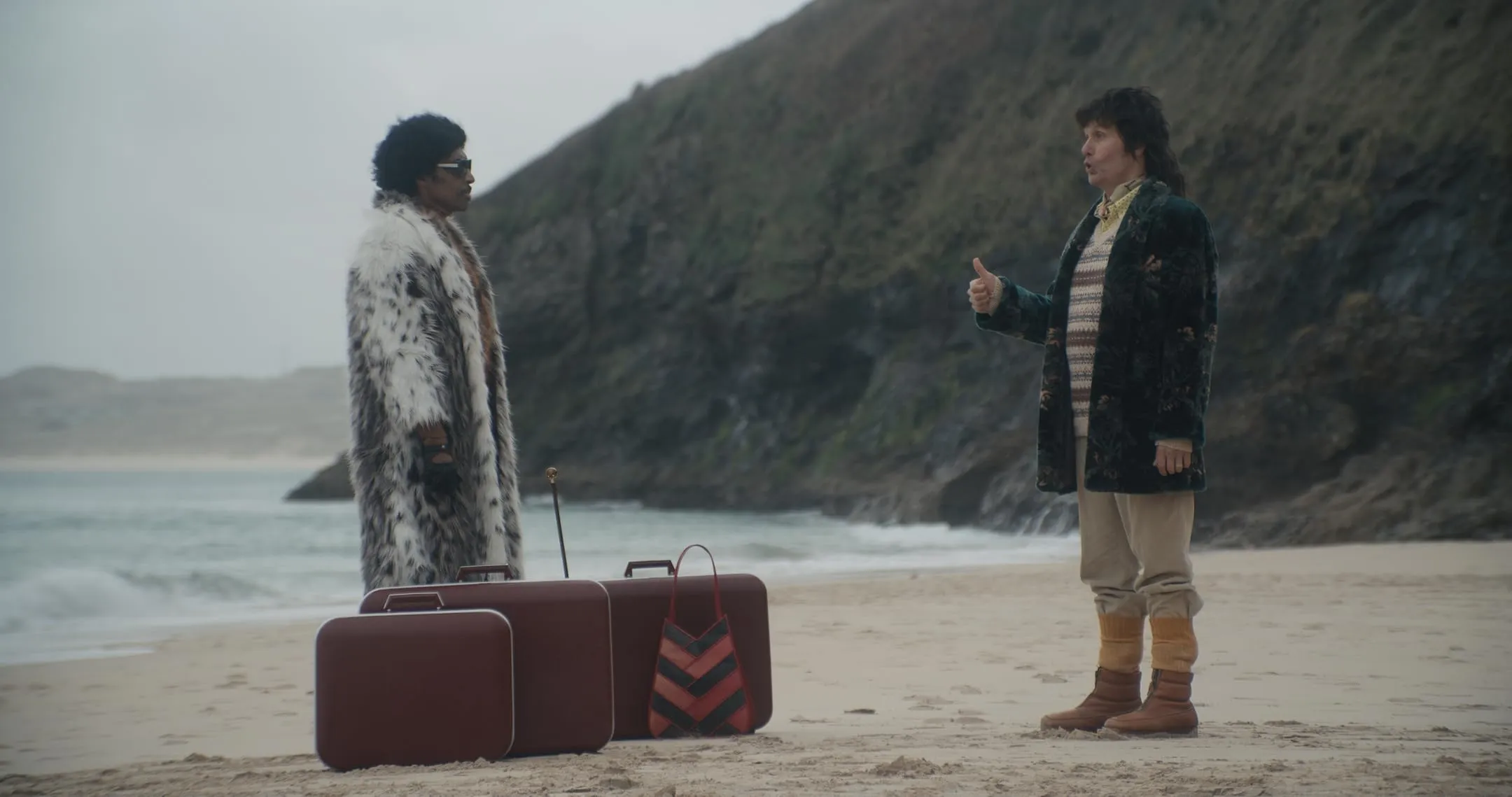Jim Hosking’s “Ebony and Ivory” is a weird twist on the musical biopic. It depicts a fabricated meeting between Paul McCartney and Stevie Wonder in a Scottish cottage.
Instead of focusing on artistic creativity, the film delves into surreal absurdity. Two musical titans engage in frivolous shenanigans while ostensibly preparing to write a song. This concept serves as a platform for commentary, mocking the superficialities of celebrity culture.
“Ebony and Ivory,” which premiered at Fantastic Fest, has sparked interest for its acceptance of the ludicrous while dissecting the cultural moment it reflects. The 1982 original song has garnered both praise and scorn. Hosking’s film reduces creativity to meaningless exchanges—complete with a “nugget slide”—raising questions about the nature of collaboration. Is it a veneer of harmony, as implied by the song’s lyrics?
This absurdist approach reflects modern society’s alienation from authentic artistic expression. In a culture characterized by superficial participation, the film’s unrelenting triviality critiques our times, asking audiences to reevaluate their expectations for artistic collaboration. The humor emphasizes these themes, inviting laughter at the silly while prompting deeper contemplation of the absurdity of our own interactions.
The Absurd Setup: A Journey Through Nonsense in “Ebony and Ivory”
In “Ebony and Ivory,” the Scottish cottage is more than just a backdrop; it embodies the film’s absurdist tone. Nestled amid the stunning shores of Mull of Kintyre, this primitive cottage transforms into a character in its own right. Two musical titans, Paul McCartney and Stevie Wonder, meet in this exquisite yet strange sanctuary.
Instead of a scene of creative collaboration, we get a scene of hilarious chaos that begins with Wonder rowing across the Atlantic. This journey feels as absurd as the film itself (one might even call it a “row-mentary” journey).
This first setup is critical. It provides an anticipation of artistic synergy, only to demolish it in favor of a series of petty alterations. The idea of two titans collaborating to create a timeless duet is undermined by their outrageous antics—a contrast that highlights the frequently silly nature of celebrity culture. (Do we expect profound artwork to emerge from a “nugget slide” that serves vegetarian food? Perhaps this reflects our cultural moment, in which substance often takes a backseat to spectacle.
As the film progresses, viewers witness progressively odd interactions that defy standard storytelling. McCartney and Wonder engage in bizarre chats about frozen food, drink ludicrous concoctions from a fictional Scottish business, and participate in a complicated hot chocolate quest. Their conversations, which range from the benefits of vegetarian cuisine to the philosophical implications of a “doobie woobie,” exemplify anti-dialogue that mimics modern society’s preference for meaningless chatter.
The film’s condemnation of artistic collaboration symbolises the absence of any true songwriting process. Instead of creating music, they engage in a hilarious dance of absurdity, removing any pretence of authenticity.
Every moment is rife with irony, demonstrating how two icons can find themselves trapped in their peculiarities rather than a shared vision. This ludicrous journey entertains and serves as a mirror, reflecting a society in which superficial connection is sometimes misrepresented as a true partnership. In this sense, “Ebony and Ivory” becomes more than just a humorous romp but a philosophical exploration of the nature of creation and the absurdity of fame.
The Idiosyncrasies of Iconic Interactions: Character Analysis in “Ebony and Ivory”
Sky Elobar’s portrayal of Paul McCartney in “Ebony and Ivory” is nothing short of an art lesson in absurdity. Elobar embodies McCartney with a blend of earnestness and perplexing naiveté, crafting a character who veers between the wonderfully odd and the utterly absurd. His McCartney is a man stuck in a world of frozen vegetarian meals and meaningless banter, exemplifying the absurdity of a musical legend relegated to minor activities.
This characterisation invites consideration of the nature of stardom, namely how icons can become caricatures of themselves in the public eye. Elobar’s McCartney frequently speaks singly, breaking into spontaneous tunes about trivial matters, highlighting the absurdity of expecting deep art from such interactions. (Some could call this “musical mundanity,” in which even the most legendary figures engage in the trivialities of everyday life.)
In contrast, Gil Gex’s portrayal of Stevie Wonder is a vortex of weirdness and black humour. Gex imbues Wonder with unhappiness, frequently cursing and emitting a palpable frustration that contrasts dramatically with Elobar’s whimsicality. This tension provides a dramatic interplay between the two characters, with Wonder’s sharp wit and caustic remarks cutting through McCartney’s absurdity.
Gex’s performance highlights the film’s thematic exploration of teamwork. His Wonder appears to be always irritated, representing the artistic nature that frequently clashes with the vagaries of celebrity culture. As their interactions alternate between friendliness and mayhem, this friction is fertile material for comedy. (One could argue that Gex’s Wonder serves as a mirror, reflecting the frequently ludicrous expectations placed on artists to preserve harmony amid creative struggles.)
Elobar and Gex create a captivatingly chaotic team, their opposing portrayals boosting the film’s exploration of artistic identity and the frequently absurd nature of collaborating in the spotlight.
The Harmony of Absurdity: Themes and Humor in “Ebony and Ivory”
At its core, “Ebony and Ivory” serves as a rowdy mockery of the original song and the music industry in general. Jim Hosking expertly dismantles the veil of artistic collaboration by providing a fabricated account of McCartney and Wonder’s meeting, exposing the follies beneath.
Instead of embodying togetherness, the film highlights the discord inherent in celebrity culture’s surface features. The original song, with its well-meaning but naive message about racial harmony, is reversed here, implying that such goals frequently fail in the face of silly human behavior.
This absurdity is not intended to startle listeners; rather, it invites them to reflect on the often manufactured nature of musical relationships. (This could be described as a “collaborative caricature,” in which artists’ egos eclipse real creative expression.) The film criticizes the industry’s tendency to prioritize spectacle over substance by showing McCartney and Wonder engaging in minor activities such as eating vegetable nuggets and creating intricate hot chocolate recipes.
The humour in “Ebony and Ivory” is a rich tapestry woven from strange speech, physical comedy, and nonsequitur moments that feel ripped from the pages of a fever dream. Hosking writes in a style reminiscent of Adult Swim’s bizarre sketches, with language that frequently drifts into the absurd. Conversations involving drug use, for example, devolve into a protracted game of telephone over a word that rhymes with “woobie.” This layering of absurdity creates a bewildering and enjoyable humorous cadence.
Furthermore, the physical comedy—characterized by the famed “nugget slide” and extensive quantities of full-frontal nudity—visualises the film’s themes. It’s as if the characters have abandoned the concept of dignity in favour of a wild exhibition of unrestrained behaviour. This juxtaposition of high-profile singers indulging in ridiculous acts serves as a statement on the strange lengths people would go to get fame.
However, a deeper resonance lies beneath the pandemonium. The humour is a lens through which viewers might question their perceptions of art and stardom. As laughter erupts, it prompts reflection: What does it mean to collaborate in a world concerned with spectacle? In many respects, “Ebony and Ivory” challenges us to evaluate the absurdity of its characters’ behaviour and the fundamental fabric of the music industry itself.
The Vision of Absurdity: Direction and Cinematography in “Ebony and Ivory”
Jim Hosking’s direction in “Ebony and Ivory” is distinguished by his distinctive absurdist humour, which celebrates the strange while pushing conventional storytelling. Hosking, known for blending the grotesque and the humour in his past works, pushes boundaries here with a level of planned and spontaneous irreverence.
His characters, especially McCartney and Wonder, navigate a world devoid of logical restrictions, allowing for a humorous narrative alternating between comedy and pain. (One may aptly label this approach “absurdist authenticity,” in which characters are exaggerated and somehow relatable.)
The film’s humour frequently derives from its willingness to dwell on awkward moments, urging audiences to accept the absurdity of the events. Hosking’s directing invites viewers to question not only the narrative but also the cultural artefacts surrounding music legends, such as how they are packaged, commodified, and ultimately consumed. Through this lens, he creates an entertaining yet thought-provoking indictment of the music industry.
Visually, “Ebony and Ivory” has a distinct look that compliments the absurdist narrative. The cinematography captures the picturesque but spooky Scottish scenery, contrasting peaceful beauty with the turmoil inside the cabin. Close-ups of untidy faces and ridiculously produced physical comedy create an unsettling mood that echoes the film’s themes of alienation and disorientation.
With quick cuts that emphasize comedic timing and enhance the film’s frantic energy, editing plays a vital role. Scenes change abruptly, frequently leaving viewers momentarily disoriented, matching the characters’ experiences as they fumble in their absurd pursuits. This style also underlines the absurdity of their conversations—what starts as a routine interaction can suddenly become a bombardment of surreal visuals and speech.
In essence, Hosking’s direction and the film’s visual style combine to create a unique environment that is both frightening and deliciously absorbing. The result is a cinematic experience that, while grounded in absurdity, resonates with deeper societal concerns. It asks audiences to reflect on their expectations of art history and collaboration in an increasingly shallow world.
The Absurd Appeal: Overall Experience in “Ebony and Ivory”
“Ebony and Ivory” invites a variety of reactions, particularly from people who enjoy absurdist art. Fans of this genre, such as Tim and Eric or Monty Python’s bizarre sketches, will find the film to be a goldmine of laughs. Its unrelenting absurdity and eccentric charm create a unique viewing experience between laughter and astonishment.
The film’s chaotic style, on the other hand, may repel more traditional audiences who want narrative consistency and emotional depth. (One would say it’s a film that requires a certain readiness to embrace the ridiculous—an invitation to wallow in the absurd rather than criticize it.)
The engagement is multilayered; some viewers may see the film as a criticism of the music industry, while others may enjoy the slapstick humour and odd antics. This duality allows “Ebony and Ivory” to resonate on multiple levels, making it a potential cult classic that feeds on its ability to divide opinion.
The film’s impact lies in its bold willingness to defy traditions, offering a stinging critique cloaked in absurdity. Its playful irreverence toward celebrity culture—especially in an era when authenticity is sometimes overwhelmed by spectacle—positions it as a critique that feels both contemporary and timeless. “Ebony and Ivory” may carve itself a spot in the annals of the cult film with its blend of surreal humour and social satire, inviting viewers to return for repeated viewings, each time discovering new layers of absurdity and wisdom.
The Review
Ebony and Ivory
"Ebony and Ivory" is a fascinating journey into absurdity, skillfully satirizing the music industry while highlighting the unpredictable dynamics between two great figures. Jim Hosking's irreverent directing and the performers' daring performances create a compelling experience that blends humour with a deeper reflection on celebrity culture. While it may alienate traditional audience members, its appeal lies in its willingness to accept the ludicrous, making it a potential cult classic.
PROS
- Unique absurdist humor that challenges traditional storytelling.
- Strong performances by Sky Elobar and Gil Gex, bringing iconic figures to life.
- Clever satire of the music industry and celebrity culture.
- Engaging visual style and creative direction by Jim Hosking.
- Potential for cult classic status due to its polarizing nature.
CONS
- May alienate viewers who prefer conventional narratives.
- Some humor can feel excessive or gratuitous.
- Lack of emotional depth in character interactions.













